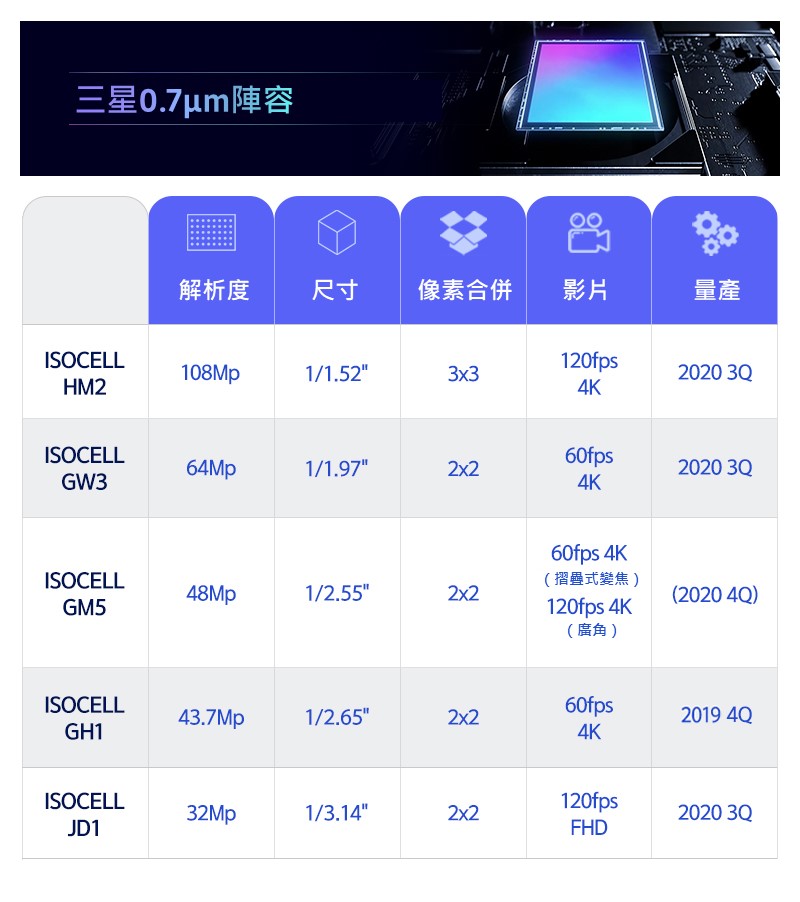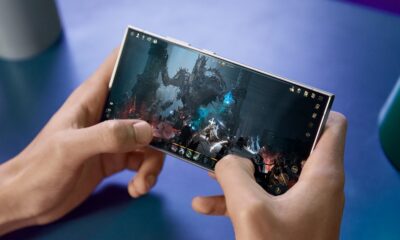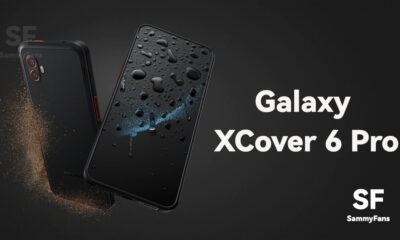News
[UPDATE]: Samsung launches new 0.7μm ISOCELL camera sensor of 108MP, 64MP, 48MP, and 32MP

UPDATE:
Samsung reveals its advanced 0.7μm-Pixel ISOCELL camera sensor on September 16, 2020. The new Samsung ISOCELL camera sensors for its 0.7 micrometers (μm)-pixel product lineup; ISOCELL HM2, ISOCELL GW3, ISOCELL GM5, and ISOCELL JD1 is now spotted in China.
The industry’s smallest pixel microchip realizes a more stylish design and a more compact camera size. A new generation of 0.7μm lineup equipped with the new ISOCELL 2.0-pixel technology will be launched at the end of the year

September 16, 2020:
Samsung has revealed a new report on its global newsroom about its Advanced 0.7μm-Pixel ISOCELL camera sensor. Samsung, today introduced four new Samsung ISOCELL camera sensors for its 0.7 micrometers (μm)-pixel product lineup; 108-megapixel (MP) ISOCELL HM2, 64MP ISOCELL GW3, 48MP ISOCELL GM5 and 32MP ISOCELL JD1. With the new 0.7μm ISOCELL technology, Samsung plans to expand the ultra-high-resolution offerings to mainstream smartphones.
“Samsung continues to pioneer innovations, such as ISOCELL Plus and Smart ISO, to deliver more pixels in a smaller package,” said Yongin Park, executive vice president of the sensor business at Samsung Electronics. “Last year, Samsung introduced the industry’s first 0.7μm-pixel camera sensor and the first 108MP sensors. Now we are bringing more of the advanced pixel technologies to mobile cameras in a variety of options that will enable high-resolution images and sleeker designs in a wider selection of tomorrow’s mobile devices.”
![]()
JOIN OUR SAMSUNG CHANNEL ON TELEGRAM
In the latest 0.7μm products to be introduced later this year, Samsung will start rolling out an enhanced pixel technology, ISOCELL 2.0, which allows excellent performance despite the challenges with decreasing pixel sizes. The new technology further enhanced the wall structure between cells, resulting in an added light sensitivity of up to 12 percent compared to the current ISOCELL Plus technology.
The New 0.7μm Lineup;
- ISOCELL HM2 is Samsung’s third 108MP camera sensor following the HMX and HM1. The new 108MP-sensor is around 15-percent smaller than the 0.8μm-based predecessors and reduces the height of the camera module by 10 percent.
- ISOCELL GW3 is a 64MP-camera sensor optimized for mainstream devices. Thanks to the smaller pixel size, the GW3’s optical size is nearly identical to that of Samsung’s 0.8μm 48MP camera sensor. In addition to Tetracell and Smart-ISO technologies that help the sensor take bright camera with high color fidelity, the GW3 is ideal for active lifestyles, featuring gyro-based electronic camera stabilization (EIS) for sharper still photos and steadier videos.
- ISOCELL GM5 is a versatile 48MP-camera sensor designed for use in telescoping or ultra-wide angle cameras. When used as a 5x optical telescoping sensor for folded-zoom, the GM5 takes full advantage of the compact 0.7μm pixel size that minimizes the camera bulge. For ultra-wide shots, the GM5 supports high-speed full-HD recording at 480fps. The sensor also offers a staggered-HDR feature, a faster and more power-efficient HDR technology that expedites image processing by sending a readout of long, medium, and short exposures of each row of pixels respectively to the mobile processor.
- ISOCELL JD1 is the industry’s smallest 32MP-cameraca sensor at 1/3.14-inches, making it an ideal solution for smartphones with bezel-less displays that incorporate a hole-in-active-area or motorized pop-up mechanism for the front-facing camera.
![]()
News
Samsung and Arm partner on parallel processing for 6G

Samsung R&D wing partners with Arm on the research of parallel processing for 6G. Samsung’s leading research and development organization collaborating with semiconductor and software design company Arm to research parallel packet processing.
SIMD, known as Single Instruction Multiple Data, is one of the key software technologies in next-gen communications. Samsung Research and Arm plans to introduce an open-source project to develop and refine parallel processing for 6G.
“This technical partnership with Arm is a significant step towards revolutionizing parallel technology,” said Jinguk Jeong, Executive Vice President at Samsung Research’s Advanced Communications Research Center.
Arm also announced leveraging its expertise in high-performance, low-power and flexible computing by collaborating with Samsung Research to accelerate the 6G software development and enable the AI infrastructure to run as efficiently as possible.
Since SIMD processes vast quantities of communication data, Samsung Research’s work with Arm seeks to significantly accelerate the research and development timeline ahead of the surge of data driven by 6G environments.
Stay up-to-date on Samsung Galaxy, One UI & Tech Stuffs by following Sammy Fans on X/Twitter. You can also discover the latest news, polls, reviews, and new features for Samsung & Google Apps, Galaxy Phones, and the One UI/Android operating system.
Do you like this post? Kindly, let us know on X/Twitter: we love hearing your feedback! If you prefer using other social platforms besides X, follow/join us on Google News, Facebook, and Telegram.
News
Young Hyun Jun will lead Samsung’s semiconductor business
Young Hyun Jun will now lead Samsung’s semiconductor business. The company today revealed that it named Young Hyun Jun as the new Head of Device Solutions (DS) Division.
President Kyehyun Kyung, who has been leading the DS Division, will become the Head of the Future Business Division as well as the Head of Samsung Advanced Institute of Technology (SAIT).
Young Hyun Jun will focus on the DS Division and strengthen Samsung’s position amid an uncertain global business environment. Notably, Jun has extensive experience in the semiconductor and battery businesses.
Samsung hired Jun in 2000 for DRAM and Flash memory development. Later, he became Head of the Memory Business in 2014 and CEO of Samsung SDI in 2017, before leading the Future Business Division in 2024.
Stay up-to-date on Samsung Galaxy, One UI & Tech Stuffs by following Sammy Fans on X/Twitter. You can also discover the latest news, polls, reviews, and new features for Samsung & Google Apps, Galaxy Phones, and the One UI/Android operating system.
Do you like this post? Kindly, let us know on X/Twitter: we love hearing your feedback! If you prefer using other social platforms besides X, follow/join us on Google News, Facebook, and Telegram.
News
Android’s hot Circle to Search arriving on iOS

Circle to Search feature may be available on the iOS platform this year. In an exciting development, folks over at the Mac Observer discovered that Google is preparing to upgrade Chrome for iOS with Android’s awesome Circle to Search feature.
Chrome for iOS silently added a new “Lens Circle to Search” flag. When enabled, it will likely bring the feature to Apple’s iOS devices. Well, it is expected to be a Lens-powered feature available within the application itself, rather than system-wide integration.
Circle to Search debuted earlier this year with the Galaxy S24 series. It’s developed by Google for Galaxy and Pixel devices. As of now, a number of Samsung and Google devices have access to it. Meanwhile, the expansion may take place to more Android vendors and iOS too.
This feature is literally powered by Google Lens. Thanks to system-wide integration, it feels like a core feature of the Android operating system. Through an app update, Google seems to be planning Circle to Search beyond Android devices.
Stay up-to-date on Samsung Galaxy, One UI & Tech Stuffs by following Sammy Fans on X/Twitter. You can also discover the latest news, polls, reviews, and new features for Samsung & Google Apps, Galaxy Phones, and the One UI/Android operating system.
Do you like this post? Kindly, let us know on X/Twitter: we love hearing your feedback! If you prefer using other social platforms besides X, follow/join us on Google News, Facebook, and Telegram.












